
340. $150
Large champlevé carriage clock, ca. 1970’s? In contrast to the two previous carriage clocks,
this clock is probably of more recent vintage. It stands almost 8.5 inches tall with the handle up. The workmanship is
of a lower quality than the European carriage clocks. It is an eight-day repeater with an alarm function and is running, keeping
very good time, but is not striking the hours. We do not have a key with this clock, but you probably have a standard clock
key that will work, and carriage clock keys can be obtained from TimeSavers. The cobalt blue enamel finish is attractive, the
dial is porcelain, there are four beveled glasses, and the bronze finish is good. There is no signature or country of origin
marked.
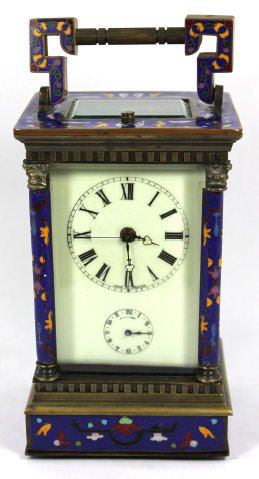
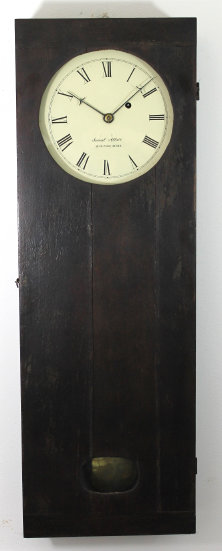
341. $2250
Samuel Abbott Coffin clock, ca. 1830. This very simple pine case with a dark and likely
original finish is 30 inches long and 10 inches wide. A similar clock is shown in Distin & Bishop, The American Clock (1983)
on page 78 and is attributed to the Shakers of Maine around 1830. There is no label, inside or out. The banjo-type movement
is signed “Abbott” and runs 8-days, time only, and is keeping excellent time if the hands aren’t pinned too tightly. Both glasses
are old, as are the hands; the heavy iron dial has been repainted. The clock is driven by a lead weight. There are 14
Sam Abbott clocks listed in the Antique Clocks Price Guide but none match this clock, and there are no coffin clocks that match either,
so pricing is hard to estimate. $2500-$4000.
342. $400
L.F. & W.W. Carter “Calendar”, 1862-1868. The rosewood case is 32 inches long in outstanding
shape, and all but the very bottom piece of the base is original. The calendar glass is old, the dial glass is newer, both have
old paper replacement dials. The upper paper dial has been lacquered, giving it the yellow color. The time and calendar
hands are correct, the weekday calendar hand is a replacement. The two-weight, 8-day time-only movement is correct, with solid
plates, retaining power, and a steel-pivoted rolling pinion. This clock came to us without weights, but we hung two 3.5 lb OG
weights to test, and the movement runs and the calendar hands advance. However, the clock stops frequently and it will need
heavier weights, I believe it calls for two cylindrical weights of about 6 lb (the OG weights will not be included). A pendulum
bob is included. There is a pretty good black label inside behind clear plastic, and a good green label on the back of the calendar
door. $500-$800.
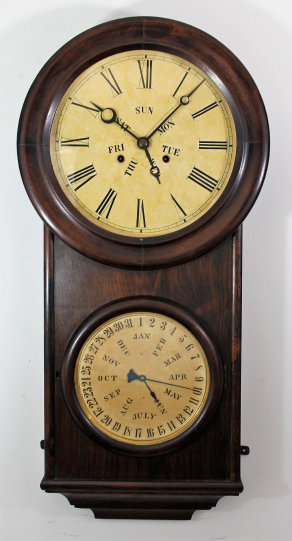
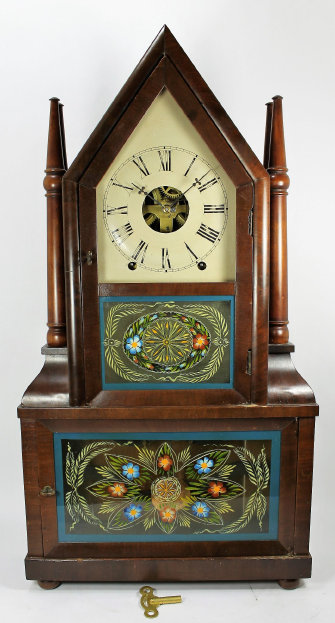
343. $1300
Birge & Fuller Candlestick Double-steeple, ca. 1844-1848. John Birge and Thomas Fuller
worked together in Bristol from 1844 until Fuller’s death in 1848. This 26-inch mahogany-veneered double-steeple holds a wagonspring-driven
signed movement. It is running and striking on the hour, but we have not gotten it to run for a full 8 days. One arm of
the wagonspring has been repaired. There are a couple of veneer chips and repairs on the upper door, barely noticeable. The candlesticks look like they might be replacements but they conform exactly to the original design; the bun feet are likely replacements. The dial is an old repaint, the hands correct. The dial glass is newer, the painted glasses are old, but both are likely repaints. I like that they match. The only real shortcoming here is the lack of label inside. The minimum is attractive; we sold
a nearly identical candlestick in September of 2015 for $2675. $1800-$2500.
344. $1250
Seth Thomas “Garfield”, ca. 1883. This classic, weight-driven shelf clock is 30 inches high,
named after the second US president to be assassinated, in 1881. The case is walnut in an old if not original finish and with
a nice amount of “patina”. The glass is original, the dial repainted long ago; the hands are original, as is the pendulum and
bob. The dial trim, weights, and damascened pendulum bob are nickel-plated; the weights and bob could use a bit of polish. A decent label inside on the bottom, no date on the back of the case. The movement is correct to this model and is running,
but would benefit from service. All in all, a nice example of this difficult-to-find classic. Our most recent sale
of this clock, also in nickel, was for $1500 in 2015. $1200-$1500.
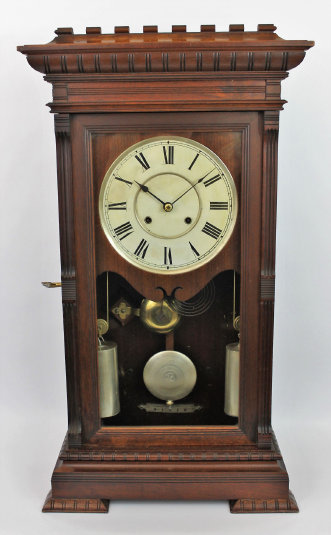

345. $65
Telechron 6B01 “The Jubilee”, 1932-38. This large electric shelf clock has an unusual feature
for a Telechron, a gong strike on the hour and half-hour – so now you could have your clock strike the hours, just like your old mantel
clock, but never have to remember to wind it! What a clever combination of old and new – and it kept perfect time unless the
power failed. Now, where to plug it in… The clock is 10.75 inches wide and 8.5 inches high. The wood case is clean
and without markings, the convex glass covers a 5.5-inch dial with a sweep seconds hand and a red dot to indicate when power has failed. The clock is running and striking appropriately. $65-$100.